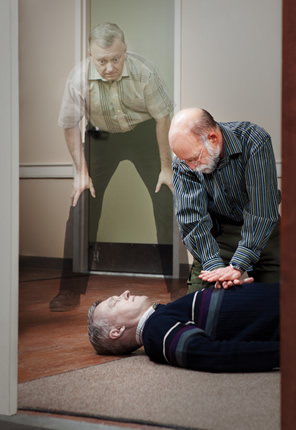Out-of-Body Experiences
 About 6% of the patients interviewed reported
having an out-of-body experience (OBE). Their perception was that
their consciousness was separate from their body, and they could
see their body from a vantage point somewhere above.
Understandably, severe pain was generally the trigger for one of
these episodes. One patient had this experience during an episode
of severe chest pain, another during child birth. Somehow, having
an OBE allows the patient to feel free from pain. The following is a description of a woman in labor who became unconscious and had an out-of-body experience.
About 6% of the patients interviewed reported
having an out-of-body experience (OBE). Their perception was that
their consciousness was separate from their body, and they could
see their body from a vantage point somewhere above.
Understandably, severe pain was generally the trigger for one of
these episodes. One patient had this experience during an episode
of severe chest pain, another during child birth. Somehow, having
an OBE allows the patient to feel free from pain. The following is a description of a woman in labor who became unconscious and had an out-of-body experience.
The pain was very severe, and I remember thinking, ‘I’ve got to get out of here. The next thing I remember, I was looking down on myself. I was on the ceiling, in the corner. I felt great. No pain at all. I could see myself, and I wasn’t frightened anymore (Lawrence, 1995).
The downside of this experience is that many
patients report having a distinct fear of being unable to get
back into their body, and general confusion about what was
happening. While they were momentarily free from their pain, they
still felt connected to their world and maintained an interest
and longing to continue in it.
Parapsychologists have studied out-of-body
experiences for years to try to establish if a part of
consciousness really does leave the body. Subjects who report
being able to have out-of-body experiences, (sometimes known as
astral projection) have been studied in controlled
laboratories. They were asked to go out of their bodies and
locate objects in different rooms or places. The
parapsychologists study how frequently the subjects accurately
identified these objects. In general, gifted subjects,
did better than subjects who were taught how to go out of their
bodies. Most of the research in inconclusive at this time.
Lawrence (2017) analyzed selective attention of subjects during transpersonal experiences surrounding death. She found subjects during OBEs were attracted to four stimuli primarily in the involuntary attention realm as opposed to the voluntary attention realm. She documented 46 accounts from 40 patients.
Four types of OBE and examples of recollections |
| 1 |
Described out of place or odd objects or events |
20% |
e.g., recalled a nurse wearing plaid shoelaces |
| 2 |
Observed their injured body or from a perspective not seen before |
30% |
e.g., recalled watching body move in response to defibrillation |
| 3 |
Observed people coming to the scene of the accident |
35% |
e.g., recalled seeing people running toward the car |
| 4 |
Spiritual body assessment |
30% |
e.g., recalled inability to touch anything or communicate |
Helpful communication with someone who has had an OBE:
- Establish a client centered rapport
- Hold in reserve your causal belief about the event
- Encourage communication about the experience
- Listen to the client’s description of the even with empathy
- Determine if the experience was visual, auditory, kinesthetic, or a combination
- Determine the client’s explanation for the experience
- Validate any veridical perceptions
- Normalize the experience
- Assess the emotional impact.
- Provide resources as needed (Lawrence, 2015)
References:
Lawrence, M. (2017). Selective attention during transpersonal experiences surrounding death. International Journal of Transpersonal Research. 9(2), 49-56.
Lawrence, M. (2015). The death view revolution: A guide to transpersonal experiences surrounding death. Guilford, England: White Crow Books.
Lawrence, M., (1995). The Unconscious Experience. American Journal of Critical Care, 4 (3) 227-232.
©RnCeus.com
 About 6% of the patients interviewed reported
having an out-of-body experience (OBE). Their perception was that
their consciousness was separate from their body, and they could
see their body from a vantage point somewhere above.
Understandably, severe pain was generally the trigger for one of
these episodes. One patient had this experience during an episode
of severe chest pain, another during child birth. Somehow, having
an OBE allows the patient to feel free from pain. The following is a description of a woman in labor who became unconscious and had an out-of-body experience.
About 6% of the patients interviewed reported
having an out-of-body experience (OBE). Their perception was that
their consciousness was separate from their body, and they could
see their body from a vantage point somewhere above.
Understandably, severe pain was generally the trigger for one of
these episodes. One patient had this experience during an episode
of severe chest pain, another during child birth. Somehow, having
an OBE allows the patient to feel free from pain. The following is a description of a woman in labor who became unconscious and had an out-of-body experience.